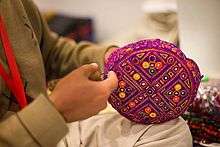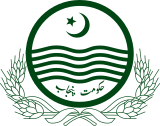Sindhi cap
.jpg)
The Sindhi cap also known as Sindhi topi and Saraiki topi (Sindhi: سنڌي ٽوپي , Saraiki: سرائیکی ٹوپی, Urdu: سندھی ٹوپی) is a hat worn predominantly by Sindhi people of Sindh province; however, it has been also adopted by the Saraiki people and Baloch people including Pashtuns. Together with ajrak or Saraiki Ajrak, Sindhi Topi is regarded as an essential part of Sindhi culture and Saraiki culture. It is also a symbol of Sindhi nationalism for hundreds of years.[1]

The hat is circular/cylindrical except for a portion cut out in the front to expose the forehead. Intricate geometrical designs are embroidered on the hat, and very often small pieces of mirror are sewed into it also. In Sindhi culture, the Sindhi cap is often given as a gift or as a sign of respect, along with the ajrak. In December 2009, "Sindhi Cap Day" was celebrated in Pakistan's Sindh province to celebrate the Sindhi cap, and Sindhi culture in general. In 2010, the day was renamed to Sindhi Cultural Day. Hand-woven Sindhi Topis are work of hard labour. it is usually celebrated on the first Sunday of every December. it is symbolic event to show the power of Sindhi culture through out the world. Sindhi Topi is primarily produced in Tharparkar, Umerkot, Sanghar, Kandhkot, Larkana, Nawabshah and some other districts of the Sindh.[2]
-

Z.A Bhutto junior
| Wikimedia Commons has media related to Sindhi topi. |
| Wikimedia Commons has media related to Saraiki topi. |
